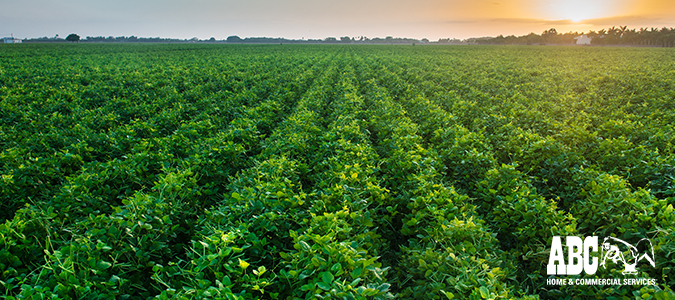Everything is bigger in Texas, including the weeds. Before you let plant predators such as cleavers, chickweed, henbit, sow thistle and wild carrot take over, learn the pros and cons of herbicides, as well as some non-chemical alternatives.
Weeds can rob nutrients from the soil and smother other plants, but they aren’t all bad. Some can help your plants grow; others you may actually enjoy. They can also act as a free soil test, telling you whether or not you need soil balancing. Certain weeds spring up only when the soil is too high or low in something.
Many times, you can organically solve your weed problem by simply getting rid of the existing weeds and then balancing the soil. Learn more about how to improve soil quality in your lawn.
Sometimes, however, herbicides are necessary. But before you start releasing chemicals around your property, it’s important to consider what they are, how they work, and what their advantages and disadvantages are.
What Are Herbicides?
Even if you’ve never heard of the term “herbicide” before, you can guess the meaning from its parts: “herb” referring to a plant and “-icide,” a suffix indicating the act of killing.
Herbicides, known more colloquially as weedkillers, are chemical mixtures used to kill and control unwanted plants. It’s extremely important to read the label from beginning to end to know how to use the herbicide safely and effectively.
Warning: It is illegal to use herbicides in any manner inconsistent with its labeling. We highly recommend enlisting the services of a professional. Remember, you are responsible for the effects of any pesticides, herbicides, fungicides or any other chemicals used on your property.
Herbicide Types
Different herbicides serve different purposes. For instance, there are non-selective herbicides (also known as “total weedkillers” or “broad-spectrum herbicides”) that do not discriminate in the plant life they target. These strong herbicides can kill all the plant material it comes into contact with, used mainly for commercial projects to clear waste ground.
Selective herbicides on the other hand, only kill certain types of weeds while leaving other plant life unharmed, such as grass. Read the herbicide label to find out which weeds it targets and how other plant life is affected.
Selective herbicides can be divided into two categories:
Pre-Emergent Herbicides kill seedlings as they emerge, preventing their growth. They are usually applied in late winter and early spring.
Post-Emergent Herbicides attack adult weeds through absorption into the plant tissue. They are usually applied in spring after weeds have already begun to grow.
In order to choose the right selective herbicide, first you have to identify the weed and the identities of the plants you wish to protect. Speak with a professional before using any herbicide to make sure it will kill the weed without harming any of the surrounding grass or garden plants.
Organic Herbicides
The term “organic herbicide” basically refers to less toxic herbicides. They are more natural and healthy, but may not always be effective.
Most of the time, natural, organic herbicides have no adverse effects. Some non-toxic substances to remove weeds include, clove oil, vinegar, cinnamon oil, lemon juice and corn gluten.
For instance, corn gluten meal is considered an organic, pre-emergent herbicide because it is entirely nontoxic. It can be effective at keeping weed roots from forming during germination, but timing and application are important. The garden may have to be dried beforehand to keep conditions from getting too wet and thus ineffective.
Here are some words to know when considering herbicides:
Persistence (“Residual Action”) – How long does it remain in place and active?
Means of Uptake – Is it absorbed by above-ground foliage, through the roots, or by some other means?
Mechanism of Action – How does the herbicide work (biosynthesis of amino acids, photosynthesis inhibition, lipid synthesis)? Some have more than one mechanism of action.
Herbicide Pros:
Quick andeffective
One of the main reasons why people turn to herbicides is because they provide a fast solution. Some herbicides can kill weeds in less than a day, while others can take weeks or more. It shouldn’t take more than a month for the weeds to fully die off.
Increases harvest
By removing weeds that compete for water, sunlight and nutrients, herbicides enable greater crop yield, leading to lower prices, greater profits and fewer food shortages.
Beautiful lawns and landscaping
In order to keep the weeds away and maintain a perfectly manicured lawn, herbicides are a near must. Homeowners will find it extremely difficult and frustrating to sustain weed-free flower beds and vegetable gardens.
Herbicide Cons
Negative health effects
Chemical herbicides can lead to health complications for both humans and wildlife. From skin rashes to death, herbicides can pose health dangers for anyone exposed to these chemicals.
Herbicide exposure causes skin and throat irritation, which is why proper clothing and masks are so important. Some herbicides have been linked to non-Hodgkin lymphoma and birth defects. Some of the common culprits are: 2, 4-D, dicamba and glyphosate.
Negative environmental effects
Herbicides can interfere with the surrounding ecology in alarming ways. They have been linked to destruction of wildlife habitats, depletion of animal and aquatic life, and air, water and soil pollution.
In addition to contaminating the soil where they have been applied, herbicides can also flow into other areas during rainfall.
May not work as you intend
Make sure you read the product label to make sure that the herbicide you have selected will kill the type of plant you want.
Can remain in soil for long periods of time
Depending on the type of herbicide and how it was applied, herbicides can persist in your soil for longs periods of time. This can be especially concerning since herbicides will begin to move through the soil and towards groundwater.
Increase of herbicide-resistant biotypes
Herbicide resistance refers to the ability of plants to evolve resistance to herbicides. Resistance has evolved in response to all types of xenobiotic chemicals, including herbicides, fungicides, insecticides and antibiotics.
Weeds have an amazing ability to adapt to the applied chemicals and build up a resistance. Chemical fertilizers, pesticides, fungicides and herbicides are full of harmful petrochemicals.
The toxicity of herbicides and the risk that comes with it seems like a high price to pay for getting rid of your weeds. That’s why we highly recommend hiring a professional with
ABC Home & Commercial’s low-impact approach will only use herbicides if necessary. And when we do, we will choose the right product and carefully pinpoint the affected area.
The Green Approach
The green, organic approach is a much better way to deal with weeds in your garden. While herbicides and chemical fertilizers can provide quick results, they tend to destroy the natural nutrients that the soil needs. When you start to use harmful chemicals, your lawn and garden can become dependent on artificial nutrients and unhealthy chemicals.
Luckily, there are many ways you can encourage and balance a healthy ecosystem in your soil, such as adding compost, using organic soil amendments, and blended organic fertilizers.
Don’t waste your time and money putting things into the soil without contacting a professional for a soil test and inspection. If you do, it will just be guesswork.
Early spring is the best time to attack weeds before they start to grow! For a healthy, great-looking lawn and garden all year, contact ABC Home & Commercial Services.

